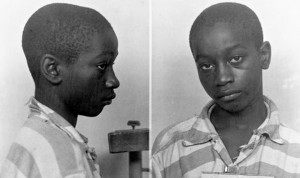
Seventy years after his death, then 14-year-old George Stinney Jr got justice of sorts when his conviction for the killing of two young white girls was vacated by South Carolina Judge Carmen Mullins on Wednesday morning.
Young Stinney was executed in that state’s electric chair less than three months after his conviction on the murder charges. His trial lasted less than three hours and a jury of twelve white male jurors took only ten minutes to hand down a verdict of “Guilty.”
When electrocuted, the 95-pound boy had to be placed on books as he was too small for the electric chair. Because the death mask on his face was too large, it fell from his face when the switch was thrown and the 2,400 volts of electricity jolted into his body.
Advocates for civil rights have spent years trying to get the case opened back up again because of claims that the young Stinney had been coerced to make a confession. Investigators told the court that Stinney had confessed to beating the young girls to death with a railroad spike. But, that wasn’t true Stinney’s sister said. She claims that Stinney was with her the day that the murders occurred and he could not have done it.
There was no physical evidence presented at the trial and his guilt was based on the fact that he and his sister had spoken with the two girls, 11-year-old Betty June Binniker and 8-year-old Mary Emma Thames, the day of their murder. Stinney’s sister said that her and her brother saw the girls briefly when they were tending their cow near the railroad tracks. The girls had asked the two where they could find “Maypops.” When the brother and sister said they didn’t know, the girls left, according to Stinney’s sister.
The girl’s bodies were discovered in a ditch on the “black side of town.” But, Reverand Francis Batson, the man who discovered the bodies, told investigators that the ditch where they were found had very little blood suggesting that the girls were killed elsewhere and dumped at that location.
Stinney’s alleged confession has never been found after all these years. In the short time in prison before his execution, he confided in a fellow prisoner, Wilford “Johnny’ Hunter, that the police made him admit to the murders.
At age 14, Stinney was the youngest person to be executed in the United States in the 20th Century.
